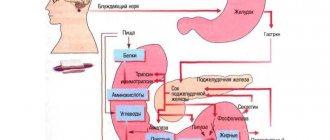General practitioner (family doctor)
Gutorova
Natalia Konstantinovna
20 years of experience
Doctor
Make an appointment
Vomiting, the spontaneous release of stomach or duodenal contents through the mouth, can have many causes. A single urge, as a rule, does not cause any particular concern and does not require close attention. However, if an adult or child vomits more than once, this is a reason to consult a doctor.
Causes of vomiting
Vomiting almost never happens without a reason: there is always something that provoked it, and there can be many options:
- food poisoning, medicines, drugs, alcohol intoxication;
- allergic reaction to a food product;
- excess food intake;
- infection;
- pregnancy (especially the first trimester);
- disease of the abdominal organs, for example, ulcer, colitis, gastritis, intestinal or stomach tumor, appendicitis, kidney failure, pancreatitis, etc.);
- intestinal obstruction;
- gallbladder pathologies (cholecystitis, hepatitis, dyskinesia, cholelithiasis);
- severe stress;
- disturbances in the functioning of the central nervous system (cerebral circulatory insufficiency, brain tumor, meningitis, mechanical head injury, migraine condition);
- problems with the vestibular apparatus;
- diabetes mellitus of any stage;
- AIDS.
With any of the above factors, standard vomiting may be observed, supplemented by other symptoms:
- abdominal pain;
- vomiting blood;
- vomiting and fever;
- vomiting bile;
- green vomit;
- vomiting, weakness;
- headache;
- heartburn;
- frequent urge to go to the toilet;
- disturbance of mental activity.
Nausea and vomiting
Nausea and vomiting can occur independently of each other, but usually they are so closely related that they can be considered together. Nausea means a feeling of an impending desire to vomit; Nausea is usually felt in the throat or epigastric region. Vomiting means the involuntary expulsion of stomach contents from the mouth; gagging refers to difficulty in rhythmic breathing, often preceding vomiting. Extremely violent “gut” vomiting is a special form of vomiting that has a specific meaning, since it can indicate the presence of increased intracranial pressure.
Nausea often precedes or accompanies vomiting. It is usually associated with decreased functional activity of the stomach and changes in the motor function of the duodenum and small intestine. Severe nausea accompanying vomiting is often a sign of changes in the activity of the autonomic nervous system (especially parasympathetic): pallor of the skin, increased sweating, copious salivation and an occasional relationship with hypotension and bradycardia (vasovagal syndrome). Anorexia is also often observed.
Following nausea that continues for some time and a short period of retching, a sequence of involuntary visceral and somatic motor acts develops, leading to vomiting. The stomach plays a relatively passive role in the development of vomiting. The main force for pushing out the contents of the stomach is provided by the abdominal muscles. When the fundus of the stomach and gastroesophageal sphincter relax, a sharp increase in intra-abdominal pressure occurs due to involuntary contraction of the diaphragm and abdominal wall. This contraction, together with the simultaneous contraction of the pylorus, causes the contents of the stomach to be pushed into the esophagus. Increased intrapleural pressure leads to further movement of stomach contents from the esophagus into the oral cavity. Reversing the direction of esophageal peristalsis may play a role in this process. The reflex raising of the soft palate during vomiting prevents stomach contents from entering the nasal pharynx, while the reflex closure of the glottis and respiratory depression help prevent aspiration of stomach contents into the lungs.
Persistent, recurrent vomiting can have detrimental effects on the body in a variety of ways. Vomiting, if it is strong and persistent enough, due to the high pressure created, can lead to rupture of the esophagus (Boerhaave syndrome) or to linear ruptures of the mucous membrane of the cardiac part of the stomach, which will cause gastric bleeding (Mallory-Weiss syndrome). Prolonged vomiting can lead to hypohydration and loss of some components of gastric juice (especially hydrochloric acid), which will lead to metabolic alkalosis, accompanied by hypokalemia. Finally, in a depressed state of the central nervous system (coma, etc.), the contents of the stomach can be aspirated into the lungs, which makes the development of aspiration pneumonitis possible.
Mechanism of vomiting.
The act of vomiting is under the control of two functionally different centers located in the medulla oblongata: the vomiting center and the chemoreceptor trigger zone. These centers are located close to each other and from other centers of the brain stem that regulate vasomotor and autonomic functions. The vomiting center controls and integrates the actual act of vomiting. It receives afferent signals from the intestine and other parts of the body, from higher cortical centers, especially from the inner ear, and from the chemoreceptor trigger zone. Important efferent pathways for vomiting are the phrenic nerves (to the diaphragm), spinal nerves (to the abdominal muscles), and visceral efferent nerves (to the stomach and esophagus).
The chemoreceptor trigger zone is also located in the medulla oblongata, but it itself is not capable of mediating the emetic act. Activation of this zone leads to the sending of efferent impulses to the vomiting center located in the medulla oblongata, which in turn causes vomiting. Dopamine receptors in the chemoreceptor trigger zone can be activated by a variety of stimuli, including drugs such as apomorphine and levodopa, after decarboxylation to dopamine.
Phenothiazine derivatives such as prochlorperazine and metoclopramide inhibit brain dopamine receptors and may be effective in treating nausea and vomiting. Metoclopramide is the prototype of selective dopamine antagonists called substituted benzamides. Unlike phenothiazines, which cause anticholinergic effects, metoclopramide has potent cholinergic effects. This action, combined with dopamine antagonism, has made metoclopramide a useful drug, equal or superior to drugs such as prochlorperazine, in the treatment of nausea and vomiting. Its usual oral dose is 10 mg 4 times daily. Metoclopramide also helps speed up the clearance of the esophagus by speeding up gastric emptying and reducing the time it takes for food to pass through the small intestine. Metoclopramide can be used intravenously in doses of 1 to 3 mg/kg as a prophylactic agent before the use of potent chemotherapeutic agents such as cisplatin.
Clinical classification.
Nausea and vomiting are common manifestations of organic and functional disorders. The exact mechanisms that trigger emesis in various clinical conditions are not well understood, making their classification difficult. The categories of these mechanisms mentioned below serve to illustrate some of the many disorders that may be accompanied by nausea and vomiting.
Many acute abdominal conditions that lead to the development of an “acute abdomen” are accompanied by nausea and vomiting. Vomiting can occur when an internal organ is inflamed, such as in acute appendicitis or acute cholecystitis, intestinal obstruction or acute peritonitis.
Nausea and vomiting can occur with many disorders associated with chronic digestive disorders. Vomiting can be either spontaneous or self-induced and can lead to a decrease in symptoms of the disease, as, for example, with uncomplicated peptic ulcers. Nausea and vomiting may accompany abdominal distension and pain seen in aerophagia-associated syndromes. In patients suffering from chronic digestive disorders, nausea and vomiting can often be triggered by eating certain foods (eg, fatty foods), although the reasons for this are not well understood.
Acute, systemic infections accompanied by fever, especially in young children, are often accompanied by vomiting and severe diarrhea. The mechanism by which infection of organs distant from the digestive tract causes these manifestations is unclear. Viral, bacterial and parasitic infections of the digestive tract can cause severe nausea and vomiting, often accompanied by diarrhea. Severe nausea and vomiting may be severe with viral hepatitis, even before jaundice develops.
Diseases of the central nervous system that lead to increased intracranial pressure may be accompanied by vomiting, often even gushing. Thus, cerebral edema caused by inflammation, hypoxemia, acute hydrocephalus, tumors, etc., may be complicated by vomiting. Damage to the apparatus of the inner ear and its central connections, which underlie dizziness, is quite often accompanied by vomiting and nausea with the urge to vomit. Acute labyrinthitis and Meniere's disease are examples of such disorders. Migraine headaches, diabetic crises, and acute meningitis are additional examples of nervous system conditions that can lead to vomiting. In the reactive phase of hypotension, accompanied by syncope, nausea and vomiting are also possible.
Severe nausea and vomiting can occur with acute myocardial infarction, especially when it is localized in the posterior wall of the left ventricle. Nausea and vomiting may also occur with congestive heart failure, possibly due to congestion of blood in the liver. It should always be borne in mind that in cardiac patients these symptoms may be caused by drugs (for example, opiates or digitalis preparations).
Nausea and vomiting usually accompany severe endocrine diseases, including diabetic acidosis and adrenal insufficiency, especially during adrenal crises. Morning sickness in early pregnancy is another example of the relationship between nausea and vomiting and hormonal changes.
Side effects of many medications and chemotherapy also include nausea and vomiting. In some cases, this is due to stomach irritation, which stimulates the vomiting center located in the medulla oblongata. Ingestion of a toxin (such as food poisoning) can also cause acute vomiting.
Psychogenic vomiting refers to vomiting that may develop as part of some emotional disorder on a transient basis or persist more persistently as part of a mental disorder. Careful observation usually reveals that the condition is regurgitation rather than vomiting, and the weight loss may not correspond at all to the patient's description of the frequency and severity of vomiting. Anorexia nervosa is an emotional disorder that may be associated not only with anorexia, but also with vomiting. Often, patients suffering from emotional disturbances and vomiting maintain a relatively normal nutritional state, since relatively small amounts of ingested food are lost during vomiting.
Differential diagnosis.
Vomiting should be distinguished from regurgitation, which refers to the expulsion of food in the absence of nausea and without contraction of the muscles of the abdominal wall and diaphragm that are part of the act of vomiting. Regurgitation of esophageal contents can occur with esophageal stricture or diverticulum. Regurgitation of stomach contents is usually observed with insufficiency of the gastroesophageal sphincter, especially in the presence of a hiatal hernia or in combination with a peptic ulcer, usually in the case of pylorospasm.
The temporal relationship between vomiting and food intake may be a useful diagnostic feature. Vomiting, which develops predominantly in the morning, is often observed in early pregnancy and with uremia. Alcoholic gastritis is usually accompanied by the development of vomiting in the early morning hours (so-called dry vomiting). Vomiting that occurs soon after eating is characteristic of pylorospasm or gastritis. On the other hand, vomiting that occurs 4-6 hours (or more) after eating and is accompanied by the release of large quantities of undigested food often indicates food retention in the stomach (for example, with diabetic gastric atony or pyloric obstruction). However, when food is retained in the stomach, vomiting can develop earlier (30-90 minutes) after eating.
When does vomiting require immediate medical attention?
Very often, even vomiting without fever is a reason to call an ambulance as soon as possible. If the patient experiences symptoms such as vomiting blood or a previous injury to the head, spine or abdomen, or if the urge does not stop, call a doctor immediately.
JSC “Medicine” (academician Roitberg’s clinic) has its own emergency department, whose specialists are ready to come to your aid 24 hours a day, 7 days a week. You can call a car by phone.
Prevention of vomiting
In order to encounter this unpleasant phenomenon as little as possible, you should follow a number of very simple rules:
- Look at the expiration date before purchasing a product . Very often, expired food causes poisoning, so you should not only not buy it, but also throw it away if it is lying around your home;
- Consume foods and drinks in moderation . This is especially true for alcohol, since taking it in large quantities provokes severe poisoning;
- Do not stay in places where toxic gases accumulate . If their influence cannot be avoided for some time, cover your nose and mouth with a cloth or a special mask, if available;
- Get regular medical checkups . If you can identify diseases and cure them, their symptom in the form of vomiting will not bother you;
- Eat right during pregnancy . Eating fatty, canned or smoked foods often provokes vomiting in expectant mothers. Give preference to the most natural, neutral products;
- Strengthen your immune system . To prevent your body from being attacked by an infection that causes vomiting, you should take care of your immune system;
- Avoid stressful situations . Try to eliminate the causes of anxiety that particularly bother you.
Nausea and vomiting are dangerous causes!
First aid for vomiting
Despite the fact that medical manipulations should be carried out by a doctor, especially if brown vomiting, white foam vomiting or black vomiting is observed, it is not superfluous to know how to provide first aid to a victim with such a symptom.
- The sick person should be placed in a horizontal position, with a basin or other container placed nearby into which he could vomit if necessary.
- If severe vomiting is accompanied by weakness, then his head should be turned to the side in order to eliminate the possibility that the person will choke on the escaping masses.
- If this is vomiting due to poisoning or for any other reason, it is necessary to rinse your mouth with a disinfectant solution after the contents of the stomach are released.
These manipulations should be performed by calling a specialist.
Vomiting of bile after eating
Vomiting with bile after eating is often explained by the fact that the pyloric valve does not cope with its functions and remains open. The causes of disruption in its work are alcohol intoxication, pyloric stenosis, chronic inflammatory processes in the gastrointestinal tract, central nervous system diseases, stress, circulatory disorders, and intestinal obstruction.
A separate condition that can lead to valve dysfunction is pregnancy. Therefore, during pregnancy, vomiting of bile may occur.
Treatment of vomiting in the clinic of JSC "Medicine" (clinic of academician Roitberg)
Often the symptom goes away on its own. However, if its appearance was dictated by the presence of a serious illness, a visit to a specialist is required. Depending on the cause of vomiting, the diagnosis may be carried out by a general practitioner, pediatrician, gastroenterologist, infectious disease specialist or gynecologist.
An experienced doctor will carry out the required diagnostics, make a diagnosis and draw up the most appropriate treatment plan, first of all prescribing anti-vomiting medication.
JSC “Medicine” (clinic of academician Roitberg) employs the best specialists of the capital and region, conducting diagnostics using the most modern equipment of proven world brands. All this together makes the treatment process quick and as convenient as possible for the patient.
You can make an appointment with a doctor by calling +7 24 hours a day or using the feedback form on the official website of the medical center. The clinic is located in the central district of Moscow at 2nd Tverskoy-Yamskaya lane, building 10, next to the metro stations “Belorusskaya”, “Mayakovskaya”, “Tverskaya”, “Novoslobodskaya”, “Chekhovskaya”.
Features of treatment with medications
First of all, you should understand how to stop vomiting. For this purpose, the doctor prescribes a special anti-vomiting remedy: it can be in the form of injections (if it is absolutely impossible to swallow anything), tablets, syrups.
Since the release of stomach contents can provoke pain, medications are also prescribed to anesthetize the mucous walls of the stomach and relieve spasms. If the symptom is accompanied by diarrhea, then medications that relieve it are prescribed as an additional measure.
Vomiting after alcohol is a separate symptom. It is not stopped in any way, since the main goal is to rid the body of toxic substances. After this, it is necessary to restore the body’s water balance, and therefore it is recommended to drink as much plain water as possible.
Treatment
Treatment should be etiological whenever possible, which does not exclude symptomatic therapy if necessary. In case of poisoning (see), gastric lavage (see) and other detoxification measures are carried out (see). For stenoses, went intestinal. tract, its tumors and certain other forms of organic pathology, surgical treatment is indicated. They treat diseases accompanied by central or hematogenous toxic R., exacerbations of chronic diseases. diseases of the digestive system.
Symptomatic therapy consists of selecting a diet, prescribing drugs that suppress R. (see Antiemetics), and correcting complications that arise from R.. Phenothiazine derivatives (aminazine, etaparazine, torekan, etc.), antihistamines (diphenhydramine, etc.), as well as drugs from other pharmacological agents are used. groups (scopolamine, haloperidol, metoclopramide). Aminazine (see) is most effective for R. caused by digitalis preparations, antibiotics, alcohol, infections, and endogenous intoxications. For R. associated with drug use, it is preferable to administer antihistamines, since phenothiazines can potentiate the effect of morphine. For the prevention of postoperative R., it is recommended to use antihistamines, and for its treatment - aminazine. Metoclopramide (Cerucal) is increasingly used for R. of various origins, which is practically free of side effects. Large doses of pyridoxine (vitamin B6) also have an antiemetic effect, which is prescribed orally or intravenously at 50-100 mg up to 6 times a day. In cases where R. is caused by inflammation of the gastric mucosa and its irritation, oral administration of anesthesin and preparations containing it (bellasthesin, pavetesin), bismuth preparations, as well as preparations containing aluminum hydroxide (almagel, etc.) is indicated, which are indicated also for R. associated with reflux gastritis, since they adsorb bile well. With persistent R., intravenous administration of fluids and solutions of electrolytes is indicated.
Recovery after vomiting
Whatever the cause of the disease, after treatment it is necessary to undergo a recovery process. It includes the following items:
- the patient must remain in bed for some time;
- You should drink liquid often and little by little; for this it is better to alternate plain water, sweet tea and low-fat broth;
- temporarily stop consuming dairy products, as well as coffee, alcohol, citrus fruits, and aspirin-based medications;
- start eating food with light dietary foods: lean meat, bananas, rice, cereals;
- For 2-3 days, completely eliminate spicy, fried, smoked, and fatty foods.
Treating vomiting at home
While at home, you can also try to stop gagging using traditional medicine methods.
- Thus, tea based on mint leaves has an excellent calming effect. This is especially true for vomiting caused by a serious stressful situation. For the same purpose, you can drink 15 drops of mint tincture with water.
- A decoction of dill seeds, which can be purchased at any pharmacy, also has a beneficial effect on the treatment process.
- Lemon juice added to plain water is a great way to get rid of vomiting.
- If this is vomiting during pregnancy, then you should stick to fractional meals. Also an effective remedy during pregnancy is chewing a slice of lemon or simple crackers in the morning without getting out of bed, so it is better to prepare them in the evening.
Answers to the most common questions
- I am vomiting and have a fever, what should I do? You should not self-medicate; in this case, it is recommended to see a doctor as soon as possible.
- What does vomiting in the morning mean? It might be worth checking to see if you are pregnant. In all other cases, you should seek medical advice from a doctor.
- White vomit with mucus - what to do? Most likely, the person has recently consumed too much white bread, milk or rice. If there are no other signs of illness, then there is no need to panic.
Diseases that cause dry paroxysmal cough with vomiting
Many people think that chest muscle spasms occur only with diseases of the lungs, bronchi and throat. In fact, such a symptom of a pathological condition may indicate various problems in the body, including changes in the functioning of the gastrointestinal tract and heart. It has been proven that coughing to the point of vomiting in adults often becomes a “bell” about the appearance of severe endocrine disorders and liver dysfunction.
Common causes of spasms occurring against the background of the gag reflex:
- Viruses, bacteria, fungi. A distinctive feature of this condition is the presence of additional symptoms of the inflammatory process - fever, sore throat, general intoxication of the body.
- Complications of acute respiratory viral infections, acute respiratory infections . With untimely or ineffective treatment of diseases of the ENT organs, the pathological condition is complicated by bronchitis, pneumonia, and tracheitis. You need to pay attention to a dry cough, with the discharge of rusty-colored sputum.
- Allergic manifestations . This category includes cough caused by bronchial asthma. If the attack is not calmed in time, chest contractions can provoke a gag reflex and complications.
- Infestation with parasites . Recent studies have shown that spasms can be caused by the spread of ascariasis to the lungs. Helminthic infestation occurs against the background of an increase in body temperature and the appearance of a rash on the skin.
- Diseases of the digestive system . Severe coughing leading to vomiting in adults is often a sign of a sharp deterioration in the condition of the gallbladder. Patients complain of thigh cramps, burning in the feet and abnormal sweating.
The most dangerous disease characterized by painful chest spasms is lung cancer. Typically, oncology does not cause fever or other symptoms of the inflammatory process.










